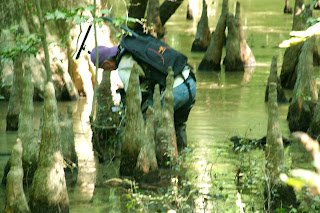Who would have thought they existed but in the southeastern corner of Oklahoma there are mystical cypress swamps tucked away in the woods. We went to the Little River National Wildlife Refuge where Dave Weaver, Manager of the Refuge took us to see some of the champion trees in the preserve.
The most exciting and magical was a huge bald cypress in the midst of a wonderful cypress swamp. The mosquitos were vicious until Dave loaned us waders and we actually walked around the massive trees and cypress trees in the swamp waters. For some reason the mosquitos mostly left us alone while Dave endured them on the shore. What a treat and how amazing to be in this special spot. At first walking into the swamp was intimidating and then it became totally addictive and engrossing. I know this spot will be in a portion of my installation in conjunction with the documentary at the Mabee-Gerrer Museum of Art. Henry Moy of the Museum of the Red River was kind enough to put us up at the Comfort Inn for our stay and I will be blogging on their truly inspiring collection.
The world's champion trees can be rated on height, trunk diameter or girth, total size, and age.
Tallest trees
The heights of the tallest trees in the world have been the subject of considerable dispute and much exaggeration. Modern verified measurements with laser rangefinders, other measuring devices, or with tape drop measurements made by tree climbers (such as those carried out by canopy researchers or members of groups like the U.S. Eastern Native Tree Society), have shown that some older measuring methods and measurements are often unreliable, sometimes producing exaggerations of 5% to 15% or more above the real height. Historical claims of trees growing to 130 m (427 ft), and even 150 m (492 ft), are now largely disregarded as unreliable, and attributed to human error. Historical records of fallen trees measured prostrate on the ground are considered to be somewhat more reliable. The following are now accepted as the top ten tallest reliably measured species (taken only currently standing specimens):
- Coast Redwood (Sequoia sempervirens): 115.56 m (379.1 ft), Redwood National Park, California, United States[12]
- Australian Mountain-ash (Eucalyptus regnans): 99.6 m (326.8 ft), south of Hobart, Tasmania, Australia[13]
- Coast Douglas-fir (Pseudotsuga menziesii): 99.4 m (326.1 ft), Brummit Creek, Coos County, Oregon, United States[14]
- Philippine rosewood (Petersianthus quadrialatus): 96.9 m (317.9 ft), Agusan del Sur, Mindanao, Philippines[15] [16]
- Sitka Spruce (Picea sitchensis): 96.7 m (317.3 ft), Prairie Creek Redwoods State Park, California, United States[17]
- Giant Sequoia (Sequoiadendron giganteum): 94.9 m (311.4 ft), Redwood Mountain Grove, Kings Canyon National Park, California, United States[15]
- Tasmanian Blue Gum (Eucalyptus globulus): 90.7 m (297.6 ft), Tasmania, Australia[18]
- Manna Gum (Eucalyptus viminalis): 89 m (292 ft), Evercreech Forest Reserve, Tasmania, Australia[18]
- Shorea faguetiana: 88.3 m (289.7 ft) Tawau Hills National Park, in Sabah on the island of Borneo[19]
- Alpine Ash (Eucalyptus delegatensis): 87.9 m (288.4 ft), Tasmania, Australia[18]
Stoutest trees
The girth of a tree is usually much easier to measure than the height, as it is a simple matter of stretching a tape round the trunk, and pulling it taut to find the circumference. Despite this, UK tree author Alan Mitchell made the following comment about measurements of yew trees:
The aberrations of past measurements of yews are beyond belief. For example, the tree at Tisbury has a well-defined, clean, if irregular bole at least 1.5 m long. It has been found to have a girth that dilated and shrunk in the following way: 11.28 m (1834 Loudon), 9.3 m (1892 Lowe), 10.67 m (1903 Elwes and Henry), 9.0 m (1924 E. Swanton), 9.45 m (1959 Mitchell) ... Earlier measurements have therefore been omitted."
As a general standard, tree girth is taken at 'breast height'. This is cited as dbh (diameter at breast height) in tree and forestry literature.[3][20] Breast height is defined differently in different situations, with most forestry measurements taking girth at 1.3 m above ground,[20] while those who measure ornamental trees usually measure at 1.5 m above ground;[3] in most cases this makes little difference to the measured girth. On sloping ground, the "above ground" reference point is usually taken as the highest point on the ground touching the trunk,[3][20] but some use the average between the highest and lowest points of ground[citation needed]. Some of the inflated old measurements may have been taken at ground level. Some past exaggerated measurements also result from measuring the complete next-to-bark measurement, pushing the tape in and out over every crevice and buttress.[21]
Modern trends are to cite the tree's diameter rather than the circumference. Diameter of the tree is calculated by finding the medium diameter of the trunk, in most cases obtained by dividing the measured circumference by π; this assumes the trunk is mostly circular in cross-section (an oval or irregular cross-section would result in a mean diameter slightly greater than the assumed circle). Accurately measuring circumference or diameter is difficult in species with the large buttresses that are especially characteristic in many species of rainforest trees. Simple measurement of circumference of such trees can be misleading when the circumference includes much empty space between buttresses.




No comments:
Post a Comment